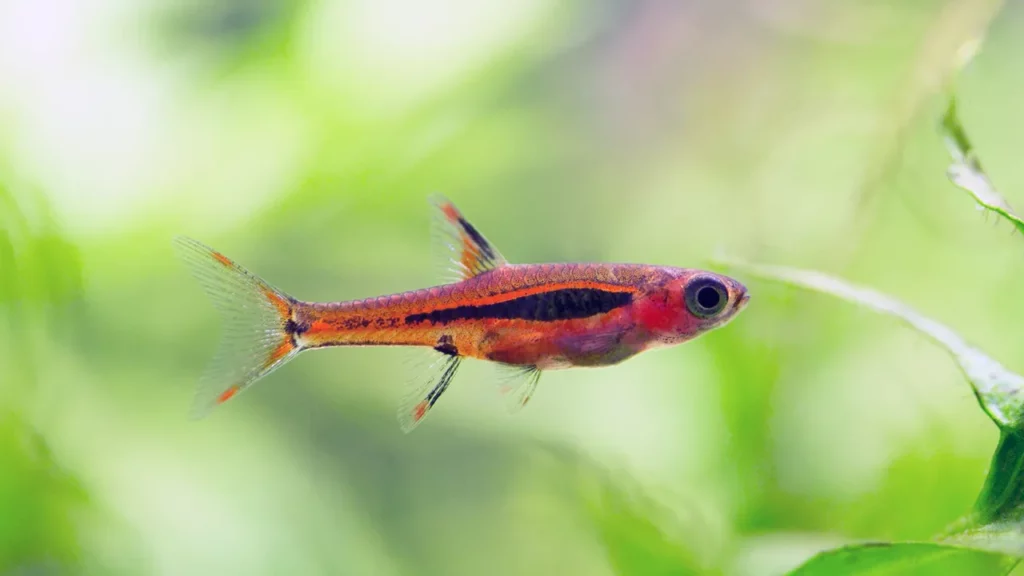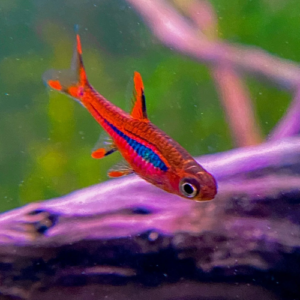Chili Rasbora Breeding Guide: The Most Important Steps
Chili Rasbora breeding is a vibrant and rewarding endeavor for aquarists. In their natural habitat, these fish thrive in shallow, dimly-lit waters surrounded by dense vegetation. To encourage breeding in captivity, one should replicate these conditions, with live plants and subdued lighting being optimal. Males, slimmer and more vividly colored than females, engage in courtship dances during the breeding process. Proper tank setup, including a soft substrate and leaf litter, can create a conducive environment for spawning.
Home » Guides » Fish Care » Chili Rasbora » Chili Rasbora Breeding Guide: The Most Important Steps
Chili Rasbora Fact Sheet
| Scientific Name | Boraras brigittae |
| Common Name | Chili Rasbora, Mosquito Rasbora |
| Care Difficulty | Easy |
| Minimum Tank Size | 10 Gallons (45 Liters) |
| Life Expectancy | 4-6 Years |
| Average Size | 0.8 Inch (2cm) |
| Temperature | 73-84°F (22-29°C) |
| Diet | Omnivore |
| Behavior | Friendly/Peaceful |
| Breeding | Medium/Hard |
| pH | 5.5-7 |
| dGH | 1-10 (0-180PPM) |
| Live Plant Friendly | Yes |
Chili Rasbora Breeding: A Colourful Undertaking
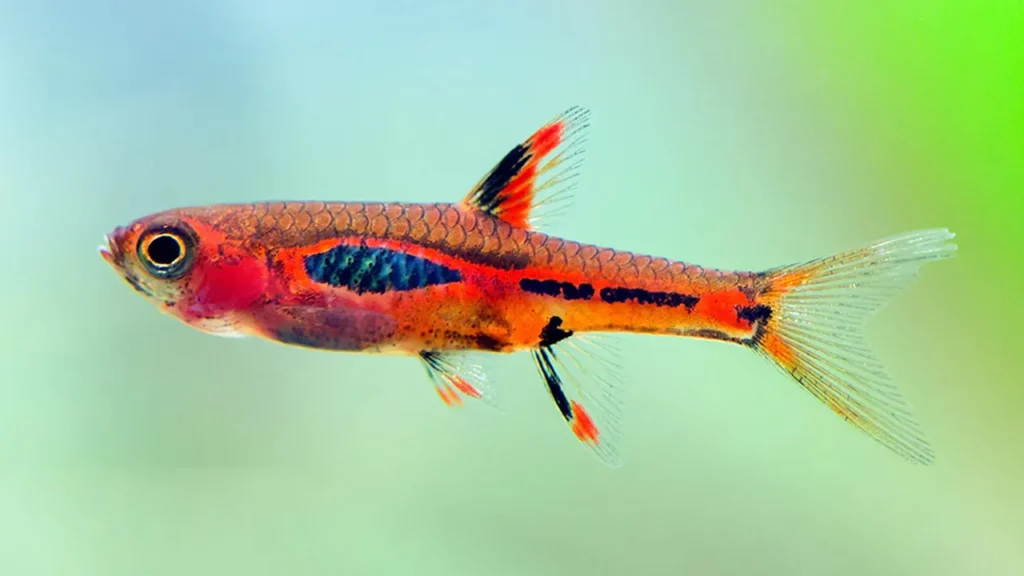
Understanding Chili Rasbora Breeding
Chili Rasboras, scientifically known as Boraras brigittae, are some of the most captivating small fish you can stumble upon. Their fiery red hue, dotted with a subtle, jet-black stripe along their midline, makes them a sight to behold. But as enchanting as these little wonders are to observe, breeding them is an art of its own—a colourful undertaking that requires a blend of patience, knowledge, and genuine appreciation for the process.
The mere act of breeding these tiny gems not only allows aquarists to populate their aquariums, but also serves as a way to connect more intimately with the mesmerizing world of fish. To breed Chili Rasboras successfully, one must go beyond the basics. It’s about comprehending the dance of life in water and ensuring that these fiery dancers have the perfect stage and ambiance to present their magic.
It is fascinating to know that while Chili Rasboras are popular in the aquarium trade, their natural habitats are limited. Originating from the blackwater streams of Borneo, these fish are acclimated to soft, acidic waters shaded by a canopy of dense vegetation. This little snippet into their natural world will set the stage for understanding their breeding needs.
Wild Breeding Behaviour of Chili Rasboras
Nature, in its raw, untouched beauty, is the most magnificent teacher. To truly understand the art of breeding Chili Rasboras, one must take a gentle stroll down the shady lanes of their native blackwater streams in Borneo. The whispering ripples, the delicate sway of aquatic plants, and the subdued light filtering through the dense canopy overhead paint a picture that’s both poetic and deeply informative for the aspiring breeder.
In the wild, Chili Rasboras are not the solitary dancers they might appear to be in our aquariums. Instead, they thrive in schools, dancing in synchronized rhythm, flitting between submerged roots and leaf litter. This schooling behavior provides them with safety against predators and, when it comes to breeding, creates a backdrop for individual pairs to stand out.
During breeding seasons, male Chili Rasboras turn especially vibrant, their fiery hues intensifying as they seek to woo their chosen females. With a flare of fins and a series of rapid, enticing movements, males establish small territories, inviting females to join them in their chosen nesting sites among the fallen leaves and delicate aquatic plants.
Females, on the other hand, when ready to spawn, develop a fuller body, making the contrast between their rich red bodies and the darker stripe even more pronounced. It’s a silent, yet deeply expressive, conversation between the two, culminating in a delicate embrace as they lay and fertilize their eggs.
These wild rituals give us profound insights into the needs and preferences of Chili Rasboras when breeding. By replicating elements of their natural habitat, we are not just offering them a conducive environment for reproduction but also paying homage to the poetic dance of nature.
Pre-Breeding Chili Rasbora Preparations
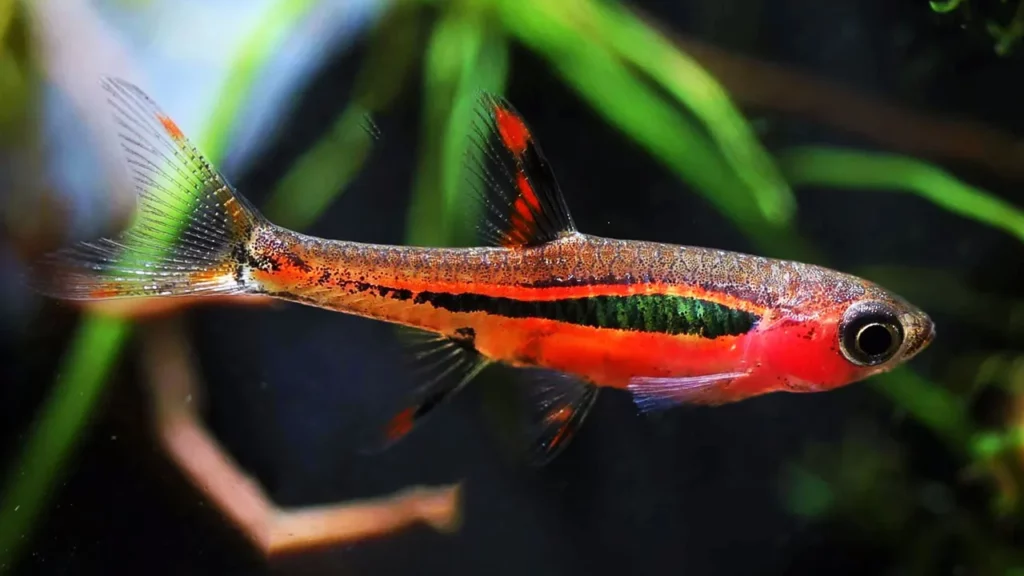
Distinguishing Male and Female Chili Rasboras
The theatre is set, and the curtains are about to rise on our breeding saga. But before the main event unfolds, one of the most crucial steps is selecting the perfect pair of Chili Rasboras to take the spotlight. This means distinguishing between the males and females – not always an easy task given their petite size and often similar coloration. But, fret not! Nature has left us some subtle cues to help in our casting call.
Males, in their quest to be the most dashing and captivating, tend to be more slender and are dressed in a brighter, more vivid shade of red. Their vibrancy is Nature’s way of saying, “Look at me! I’m the top choice!” When they are in the prime of their youth and ready for breeding, their colors intensify, almost as if they’ve been freshly painted by a passionate artist.
Females, the ever-graceful counterparts, have a slightly fuller, rounded body, particularly noticeable when they are carrying eggs. Their colors, while still radiant, are somewhat subdued compared to the males. The pronounced contrast between their main body hue and the dark lateral stripe also becomes a distinguishing feature.
When selecting a pair, it’s essential to watch out for active, healthy fish. Vibrant colors, clear eyes, and fluid swimming movements are good indicators of prime health. Remember, a harmonious pair that’s comfortable with each other will increase the chances of successful breeding. It’s like matchmaking, where chemistry plays a vital role.
And as much as distinguishing between the sexes is an art, it’s also about intuition. Trust your instincts, and more often than not, the subtle cues and behaviors of the Chili Rasboras will guide you towards making the perfect choice.
Designing the Breeding Tank
Setting the stage for our Chili Rasbora stars is more than just filling a tank with water. It’s about crafting a love nest, a sanctum of comfort and familiarity that speaks to their wild hearts.
Tank Size: Considering the petite stature of our little firecrackers, a 5 to 10-gallon tank often suffices for breeding. While larger tanks can be used, keeping it within this range allows for easier monitoring of the breeding pair and their subsequent offspring.
Substrate: Transport them back to their native streams with a dark, fine-grained substrate, reminiscent of the soft, shadowed riverbeds of Borneo. This not only brings out their colors but also creates a comfortable environment for spawning.
Plants and Decor: It’s all about creating those cozy nooks and crannies. Incorporate dense patches of fine-leaved plants, such as Java moss or spawning mops, which offer excellent spots for egg deposition. Driftwood, leaf litter (like Indian Almond Leaves), and floating plants can further replicate the shaded, tranquil ambiance of their natural habitat.
Filtration: Gentle is the keyword here. A sponge filter, with its mild water flow, is ideal. Not only does it provide biological filtration without creating strong currents, but it also ensures that the tiny eggs or fry aren’t sucked up or disturbed.
Lighting: Remember those serene blackwater streams, dimly lit by the canopy above? Aim to mimic this by providing subdued lighting. Too bright, and you risk stressing the fish. Too dark, and you’ll miss the enchanting dance. Just the right amount, and magic happens!
Temperature and Heater: Chili Rasboras thrive in warmer waters, typically between 75°F to 80°F (24°C to 27°C). It’s beneficial to include an adjustable heater with a thermostat to maintain a consistent temperature, especially crucial during the egg incubation phase.
Achieving Optimal Water Parameters
Water, the lifeblood of our aquatic companions, is more than just H2O. It’s a dynamic tapestry of elements, minerals, and parameters that needs to be carefully balanced to echo the comforting embrace of the Chili Rasbora’s native habitat.
pH Levels: Their blackwater origin means Chili Rasboras have a penchant for slightly acidic waters. A pH range between 5.5 to 6.5 hits the sweet spot. Using peat moss or the previously mentioned Indian Almond Leaves can naturally reduce and stabilize the pH to these acidic levels.
Hardness: Soft water is the order of the day. A general hardness (GH) of 1 to 5 dGH and a carbonate hardness (KH) of 1 to 2 dKH is what you should be aiming for. Using distilled water or reverse osmosis (RO) water, mixed with a bit of tap water, can help achieve these parameters.
Ammonia, Nitrite, and Nitrate: These are the three parameters you always want to keep in check. While ammonia and nitrite should always be at zero (they’re harmful even at low levels), nitrate levels should be kept low, ideally below 20 ppm. Regular water changes and a well-maintained filter will help in this.
Tannins: Remember the dark, tea-colored waters of their home streams? Tannins, released by driftwood and leaf litter, not only provide this tint but also have beneficial antibacterial properties. They create a soothing environment and can even act as a spawning trigger for our Chili friends.
Water Changes: Fresh water, introduced gently and regularly, keeps the environment pristine. Opt for smaller, frequent water changes over larger, infrequent ones. This ensures stability and reduces stress.
Oxygenation: While Chili Rasboras don’t need a torrent of bubbles, good oxygenation is essential. A softly bubbling sponge filter usually does the trick, ensuring there’s enough oxygen without creating tumultuous currents.
Spawning and Fertilization
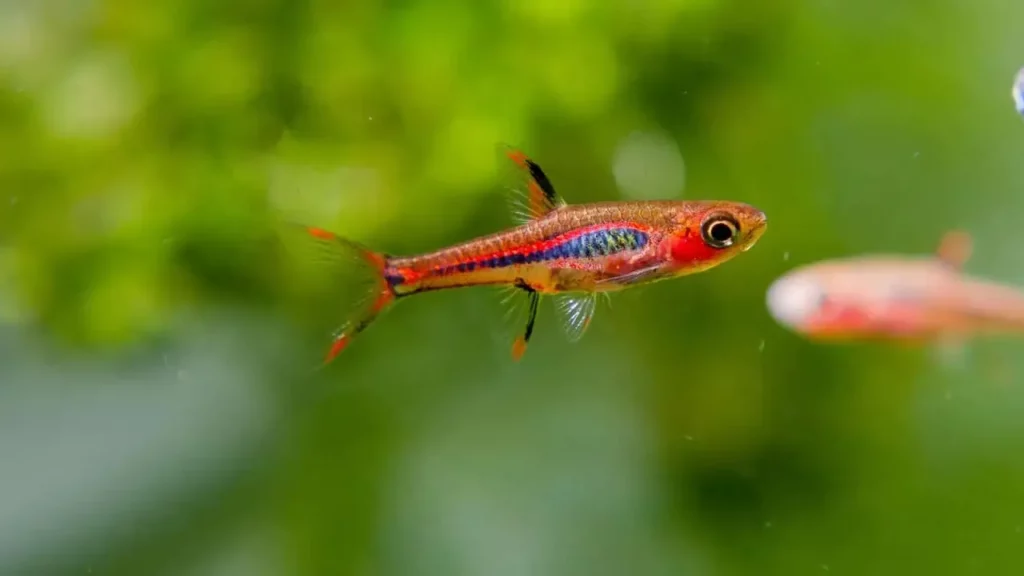
Chili Rasbora Spawning Triggers
Like any passionate dance, the breeding ritual of Chili Rasboras needs the right mood, rhythm, and cues to truly come alive.
Dietary Delights: A varied, high-quality diet is the proverbial box of chocolates in the fish world. Offering a mixture of dry foods fortified with essential nutrients, coupled with live or frozen delicacies like brine shrimp or daphnia, can enhance their vigor and get them in the mood. Think of it as wining and dining them before the big dance.
Water Changes with Cooler Water: One of the most effective triggers is mimicking the onset of the rainy season. A partial water change using water that’s slightly cooler (by about 2-3°C) than the tank’s current temperature can signal the start of a fresh breeding season, much like rain showers do in their natural habitat.
Tannins and Leaf Litter: As mentioned earlier, the addition of Indian Almond Leaves or other sources of tannins not only creates the right ambiance but can also act as a trigger. The gentle release of tannins, making the water slightly more acidic and darker, simulates the conditions Chili Rasboras would encounter during their breeding periods in the wild.
Subdued Lighting: Too bright, and the romance fades. By providing a more muted, dawn or dusk-like lighting, you’re setting the scene for intimacy, reminiscent of their shadowed, canopy-covered native streams.
Peaceful Tankmates (or Lack Thereof): While Chili Rasboras are generally peaceful, ensuring that there aren’t any overly active or larger fish in their breeding space can reduce stress and distractions, allowing the pair to focus on each other.
The Right Music: Not literal tunes (though who’s to say a bit of Barry White wouldn’t help?), but rather the harmony of the tank. The gentle hum of the filter, the soft rustle of plants and leaves, and the consistent water parameters—all these create a symphony that tells our fiery dancers it’s time to take the stage.
The Process of Fertilization
The Prelude: As the male becomes more vibrant and his colors more pronounced, he will begin to display more aggressively, showing off his best angles and making quick, enticing darts around his chosen lady. This isn’t just for show—it’s his way of signaling his readiness and his desire to partner up.
Choosing the Spot: The male, ever the gentleman, will scout and choose an ideal location for the eggs to be deposited. This is often among the fine-leaved plants or the specially placed spawning mops, but can also occasionally be on the underside of broad leaves or within the sheltered crevices provided by leaf litter.
The Embrace: The dance reaches its crescendo when the female accepts the male’s invitation. In a delicate embrace, often referred to as the ‘T-position’, the female will curve her body against the male’s. This is the moment the eggs are released and simultaneously fertilized by the male. It’s a fleeting, yet profoundly beautiful act of union.
Egg Release: A female Chili Rasbora, depending on her age and health, can release anywhere from a few to a couple of dozen eggs during each embrace. These eggs are adhesive, sticking to the chosen substrate or vegetation where they were deposited.
Multiple Rounds: The dance isn’t just a one-off. The pair will often engage in multiple rounds of this ritual until the female has released all her eggs. It’s a testament to the enduring stamina and dedication of these tiny creatures.
Observing this dance, one can’t help but be moved by its simplicity and elegance. It’s a gentle reminder of the rhythms of nature, pulsing through even the smallest of beings. But as the dance concludes, a new responsibility emerges: the care and protection of the next generation. This delicate phase warrants our utmost attention and care.
Caring for the Chili Rasbora Eggs
Once the dance concludes and the tiny eggs are securely placed, our responsibilities shift. It’s no longer just about the passionate dancers, but about the silent promises contained within those minuscule orbs.
Separation and Safety: While Chili Rasboras aren’t notorious egg-eaters, it’s always a good practice to either move the parents to a different tank or have the eggs in a separate breeding container within the same tank. This ensures the eggs remain undisturbed and safe from potential nibbles.
Maintaining Water Quality: Clean water is paramount during this delicate phase. Keeping ammonia and nitrites at zero, and nitrates low, ensures a healthy environment for the eggs. A gentle air stone or sponge filter can help maintain oxygenation without creating turbulence.
Fungal Fears: Eggs, especially unfertilized ones, are prone to fungal infections. It’s crucial to remove any white or cloudy-looking eggs, as these are usually infertile and can attract fungus. Using a turkey baster or pipette can help in this precision task. Additionally, Indian Almond Leaves or commercial antifungal treatments can be considered to reduce the risk of fungal outbreaks.
Optimal Temperature: Temperature consistency becomes even more vital now. A steady temperature between 77°F to 80°F (25°C to 27°C) can provide the optimal environment for the eggs to develop. It’s this warmth that acts as the nurturing cradle, ensuring the embryos inside the eggs develop well.
Dim the Lights: Continuing with subdued lighting during the incubation period mimics the naturally shaded environments of their habitats. This not only reduces stress but also lessens the chances of algae blooms, which could compromise egg health.
Patience and Observation: While it might be tempting to constantly check on the eggs, it’s essential to maintain a balance. Regular, non-intrusive observations can keep you informed about their progress without causing undue stress.
From Eggs to Fry
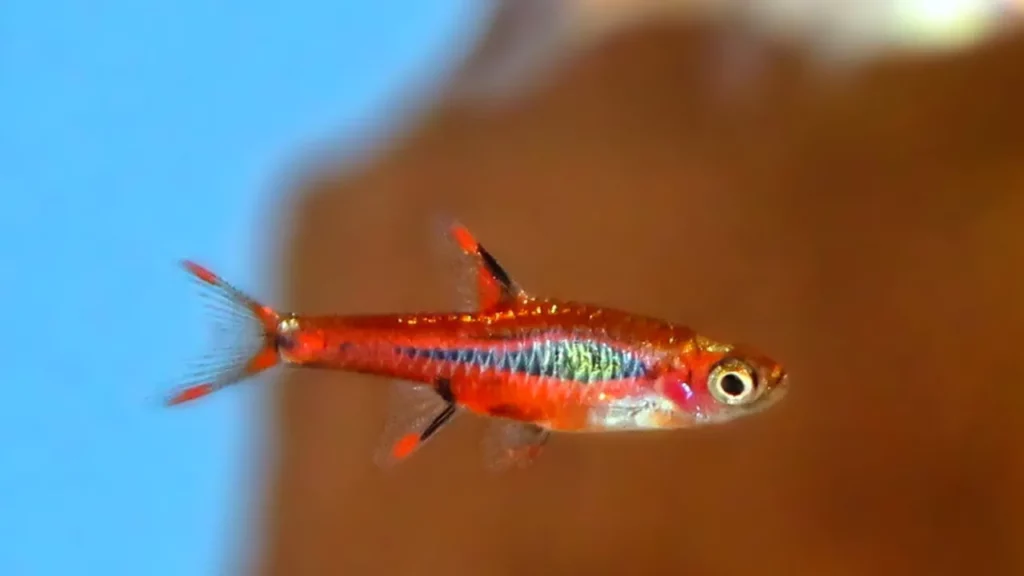
The Incubation Period
The time between the delicate act of spawning and the emergence of fry is a suspenseful interlude, a time when nature takes its course, and our primary role is that of a watchful guardian.
Duration: Typically, for Chili Rasboras, the magic unfolds relatively quickly. Depending on the temperature and conditions, the eggs will hatch within 24 to 48 hours. But remember, like waiting for a pot to boil or a watched clock to tick, it might feel like a small eternity. Your patience, however, is about to be rewarded.
Appearance: Over this brief period, you might notice the eggs undergoing a transformation. Initially clear or slightly yellowish, they’ll gradually showcase a tiny dark speck inside – this is the developing embryo. As hatching nears, you may even spot a tiny tail curled within the egg, an exciting preamble to the main event.
Disturbances to Avoid: While it’s tempting to hover, it’s best to minimize disturbances around the tank. Sudden movements, loud noises, or abrupt changes in light can stress the embryos. Ensure that their surroundings are serene, mimicking the gentle lull of their natural habitat.
Equipment Check: It’s essential to make sure all equipment in the tank is working optimally. The gentle flow from the sponge filter and the consistent warmth from the heater are pivotal during this time. A quick daily check, without causing much disturbance, will ensure everything’s on track.
Anticipating Hatching: As the incubation period draws to a close, you might witness tiny movements within the eggs. This is a sign that the fry is getting ready to break free. Keep your water parameters stable and prepare yourself for the exhilarating moment.
Chili Rasbora Fry
The moment you’ve been eagerly awaiting has arrived. Out of the tiny confines of the eggs, the baby Chili Rasboras, or fry, make their grand debut.
First Glimpse: Initially, Chili Rasbora fry are minuscule, translucent beings, often with a yolk sac attached. This sac, a little nutrient-packed lunchbox, provides them with the sustenance they need during their first hours of life. Because of their small size and transparency, they can be somewhat challenging to spot against the backdrop of the tank. Look for tiny wiggling entities, especially close to where the eggs were placed.
Staying Low: In their initial stages, you’ll find the fry staying close to the bottom, hiding among the substrate, plants, or any other provided shelters. This behavior is instinctual, designed to protect them from potential predators. Over time, as they gain strength and confidence, they’ll start venturing higher in the water column.
Morphological Changes: As days pass, the fry will start to show slight coloration and will develop more recognizable fish-like features. The yolk sac will be entirely consumed, and they’ll start resembling miniature versions of their parents, albeit with much less color.
Observing Their Behavior: Watch the fry for cues on their health and comfort. Active swimming, even in short bursts, and a keenness to explore are signs of healthy fry. On the contrary, if they are excessively listless or are not moving for extended periods, it might be an indicator of stress or ill health.
Counting Your Blessings: It can be a delightful exercise (and sometimes a challenge) to count the number of fry that have emerged. Not all eggs will hatch, and not all fry will make it through their initial days, but each tiny life is a testament to the success of your breeding venture.
Feeding the Baby Chili Rasboras Fry
It’s feeding time in the nursery, and just as a new parent might fret over the first meal, so does the aquarist for these little wonders. Proper nutrition is the cornerstone of healthy growth, so let’s explore the dietary needs of baby Chili Rasboras.
The Yolk Sac Phase: In their initial hours, the fry will rely on the nutrients from their attached yolk sac. Think of this as their first packed lunch. During this time, there’s no need to introduce external food, allowing them to naturally consume this resource.
First Foods: Once the yolk sac is depleted, usually within a day or two, it’s time for the fry’s first meal. Infusoria, a collection of microscopic organisms, are an excellent first choice. These tiny critters are easily consumed by the fry and provide essential nutrients.
Alternative Foods: As the fry grow, their mouths become bigger and their appetites fiercer. Microworms, newly hatched brine shrimp (often termed as ‘baby brine shrimp’ or BBS), and rotifers can then be introduced. These live foods are not just nutritious but also encourage the fry’s natural hunting instincts.
Frequency and Quantity: Young fry have voracious appetites and rapid metabolism. It’s beneficial to feed them small quantities multiple times a day. Overfeeding should be avoided, however, as it can degrade water quality. After feeding, a gentle siphoning of the tank’s bottom can help remove any uneaten food.
Transition to Regular Food: As the fry mature and increase in size, they can be gradually introduced to finely crushed flake food or micro pellets. The transition is a significant milestone, signaling their progression towards juvenile stage.
Water Quality: During these early feeding stages, maintaining pristine water conditions is essential. Regular water changes, using dechlorinated water of the same temperature, can help in preventing any build-up of harmful waste.
Overcoming Challenges
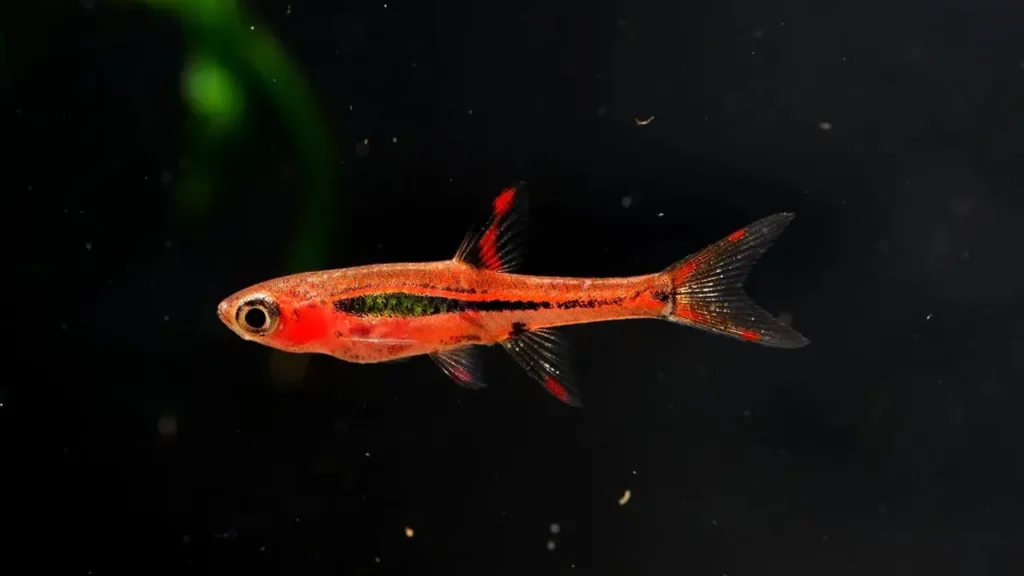
Common Breeding Problems
Breeding, as magical as it is, doesn’t always go as scripted. The path from courtship to hatching can sometimes be strewn with obstacles.
Mating Dilemmas: Sometimes, even with a perfectly matched pair, spawning doesn’t commence. It could be due to stress, unsuitable water parameters, or just the whims of nature. Ensuring a tranquil environment, adding live plants for cover, and tweaking water conditions might nudge them in the right direction.
Egg Fertility: Not all eggs will be fertile, and it’s a natural part of the process. Unfertilized eggs appear cloudy or white and can become a hotspot for fungal growth. Regular inspection and prompt removal of these eggs can prevent contamination of the healthy ones.
Egg Predation: Even the most docile fish can turn into unexpected egg munchers. To safeguard the future brood, consider separating the adults post-spawning or using breeding containers that protect the eggs while allowing water circulation.
Fungus Attacks: As touched upon earlier, fungal infections can be a bane during the incubation phase. Maintaining clean water, promptly removing unfertilized eggs, and considering natural antifungals (like Indian Almond Leaves) can help ward off these unwanted invaders.
Environmental Instability: Fluctuations in water parameters, especially temperature, can negatively impact egg development. Investing in a reliable heater and routinely monitoring the water can ensure a stable environment conducive to hatching.
Low Fry Survival Rates: It’s not uncommon for not all fry to make it past their initial days. This can be due to genetic issues, lack of proper nutrition, or water quality problems. Ensuring the fry receive appropriate food and maintaining optimal water conditions can bolster their survival chances.
Disease Prevention and Remedies
The foundation of successful breeding is healthy, vibrant fish. Unfortunately, even in the best-maintained aquariums, ailments can arise, posing challenges for breeders.
Stress and Its Impact: Stress is a silent saboteur, weakening the immune system of fish and making them susceptible to diseases. Crowded tanks, aggressive tank mates, rapid changes in water conditions, or frequent disturbances can lead to stress. Recognize signs such as erratic swimming, faded colors, or hiding behaviors. Addressing the root causes and creating a peaceful environment is the first line of defense.
Quarantine Procedures: New additions to your tank? Always quarantine them first. A separate tank, where new fish are kept for a few weeks, can help identify and treat potential illnesses before they’re introduced to the main aquarium.
Regular Observations: Make it a habit to observe your fish daily. Look for signs of distress, like clamped fins, white spots, or unusual lumps. Early detection can make treatment more effective and reduce the chances of a disease spreading.
Nutrition: A balanced diet isn’t just essential for growth; it’s crucial for immunity too. Varied and high-quality foods, rich in vitamins and minerals, can help fortify your fish against diseases.
Disease Identification and Treatment:
- Ich (White Spot Disease): Identified by white spots on the body and fins, it’s caused by a parasite. Raise the tank temperature gradually (about 2-3°F per day) to around 86°F and consider over-the-counter treatments.
- Fin Rot: Tattered or receding fins can be a sign. Improve water conditions, and if needed, use antibacterial treatments available in pet stores.
- Internal Parasites: Indications include a thin body despite regular feeding or stringy feces. Specialized anti-parasitic foods or medications can be employed.
Regular Maintenance: A clean tank is a healthy tank. Regular water changes, substrate siphoning, and filter maintenance help in maintaining pristine water quality, reducing the chances of diseases.
Natural Remedies: Some aquarists swear by natural remedies, like Indian Almond Leaves or garlic-infused foods, for their antibacterial and antiparasitic properties.
The journey of breeding isn’t just about understanding the nuances of spawning or fry care; it’s about ensuring each fish’s overall well-being. Embracing a holistic approach, where the health of the Chili Rasboras is prioritized, not only facilitates successful breeding but also enriches the overall aquarium experience. Because in the shimmering dance of these colorful fish, in their radiant health and vitality, lies the true joy of aquascaping.
Frequently Asked Questions – FAQ
Give Us Feedback
Please help us get better by making suggestions or giving feedback, we really do listen to it!
Articles You Might Like
